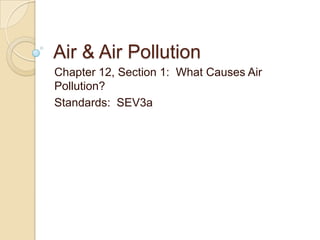
Unit 5 ch 12 s1 what causes air pollution
- 1. Air & Air Pollution Chapter 12, Section 1: What Causes Air Pollution? Standards: SEV3a
- 2. What is the normal composition of air? 78% Nitrogen 21% oxygen 1% various other gases like ◦ Argon ◦ Carbon dioxide ◦ Water vapor
- 3. What is air pollution? Any harmful substance that builds up in the air to unhealthy levels. Can be natural: pollen, dust, gases from volcanoes Mostly human caused: car exhaust, coal-fired power plants, industrial pollution, etc.
- 4. What is the difference between a primary and secondary pollutant? Primary pollutant ◦ Put directly into air by human activities Ex: Sulfur dioxide released from burning fossil fuel. Secondary pollutant ◦ Primary pollutants react with other primary pollutants or water vapor to make a new substance Ex: Sulfur dioxide mixes with water in atmosphere and causes acid rain.
- 5. What are the 5 primary air pollutants? 1. Carbon monoxide 2. Nitrogen oxides 3. Sulfur dioxides 4. Volatile Organic Compounds 5. Particulate Matter
- 6. 1. Carbon Monoxide (CO) Description: ◦ Odorless, colorless ◦ Poisonous ◦ From incomplete combustion of fossil fuels Primary Source: ◦ Vehicles (cars, trucks, buses) ◦ Industrial processes Effects: ◦ Blood can’t carry oxygen as well, feel sleepy & disoriented; can cause
- 7. 2. Nitrogen Oxides (NOx) Description: ◦ Can be yellowish gas ◦ Forms under high temps Primary Source: ◦ Vehicles (cars, trucks, buses) ◦ Power plants ◦ Industrial boilers Effects: ◦ Brownish haze from smog comes from NOx ◦ Some acid precipitation ◦ Makes body vulnerable to respiratory disease & cancer
- 8. 3. Sulfur dioxides (SO2) Description: ◦ Pungent smell Primary Source: ◦ Burning fossil fuels Power plants Refineries Smelters ◦ Volcanic activity Effects: ◦ Contributes to acid rain ◦ Harm plants ◦ Irritate respiratory system
- 9. 4. Volatile Organic Compounds (VOCs) Description: ◦ Organic chemicals ◦ Vaporize readily ◦ Form toxic fumes Primary Source: ◦ Vehicles (cars, trucks, buses) ◦ Burning fossil fuels Effects: ◦ Contribute to smog formation ◦ Harm plants ◦ Linked to cancer
- 10. 5. Particulate Matter (PM) Description: ◦ Tiny pieces of liquid or solid matter Primary Source: ◦ Construction, agriculture, forestry, fires ◦ Vehicles, power plants & Industrial processes Effects: ◦ Form clouds & reduce visibility ◦ Small pieces can be inhaled & clog respiratory system ◦ Linked to cancer ◦ Corrode metal & erode buildings Divided into: Fine particulate matter (PM 2.5)- from burning fossil fuels; worst because can be inhaled deeper into lungs Coarse particulate matter (PM10)- incinerators, mining, cement plants
- 11. How long have air pollution problems been around? As early as 2000 years ago, people complained of “foul air” Air pollution problems became worse around the Industrial Revolution of the 1800’s when fossils fuel usage increased and no standards existed for how much pollution Weather History: The Great Smog of 1952- London
- 12. What are two main sources of air pollution? 1. Motor Vehicle Emissions 2. Industrial Air Pollution
- 13. What are Motor Vehicle Emissions? Fumes & particulates produced from the burning of gasoline in vehicles 1/3 of air pollution comes from gasoline burned by vehicles. Clean Air Act- ◦ regulates vehicle emissions ◦ Banned lead in gasoline- lead pollution has decreased by 90% in US. ◦ Catalytic converters clean exhaust gas EPA says vehicles today burn fuel 35% more efficiently and with 95 % fewer emissions (except CO2) than they did 30 years ago.
- 14. What are Zero-Emissions Vehicle (ZEV) Programs? Established in CA, MA, ME, NY, & VT Offer rebates, tax incentives, closer parking, use of special HOV type lanes for ZEVs Types of ZEVs: ◦ Electric cars- plug in to recharge ◦ Hybrid cars- run on both gas and electric ◦ Methanol fuel cell cars
- 15. What are Industrial Air Pollutants? Any industry or power plant that burns fuel to produce energy Power plants produce ◦ 2/3 of all SO2 emissions ◦ 1/3 of all NOx emissions VOCs are common type ◦ From dry cleaning fumes
- 16. What are Industrial Air Pollutants? Clean Air Act requires one of the following: ◦ Scrubbers installed in smoke stacks to control air pollution Gases move through spray of water that dissolves the pollutant ◦ Electrostatic Precipitators Use static electricity to attract particulates from burning of fossil fuels
- 17. What is smog? Air pollution that hangs over urban areas and reduces visibility. Car exhaust reacts with air & sunlight to make ground level ozone. Ozone reacts with more car exhaust to make smog. Smog in Beijing, China (~2min)
- 18. What is a Temperature Inversion? Circulation keeps air pollution from reaching dangerous levels. If a warm air mass traps a cool air mass it will trap pollution with it. Usually common in cities surrounded on 3 sides by mountains. Mountains trap the air. Donora, PA (1948)- 18 people died when temperature inversion trapped SO2 & HF pollution being released from a local steel mill.
- 19. You should be able to… Name 5 primary pollutants & give important sources for each. Name the 2 major sources of air pollution in urban areas. Describe the way in which smog forms. Define the term temperature inversion. Explain how temperature inversion traps pollutants near Earth’s surface.